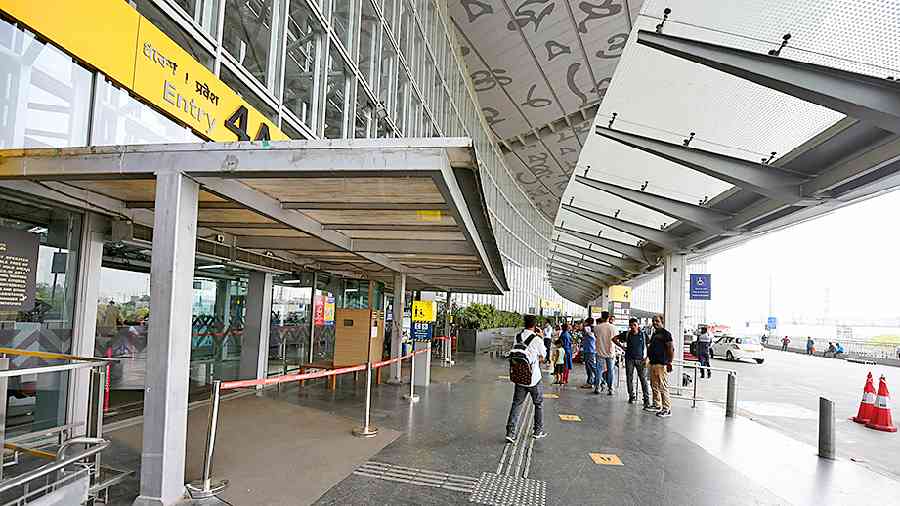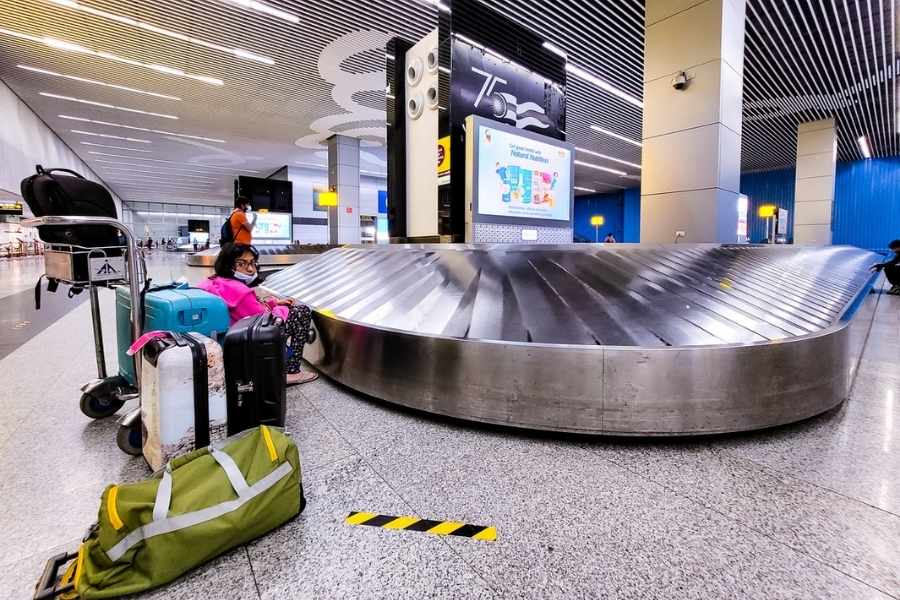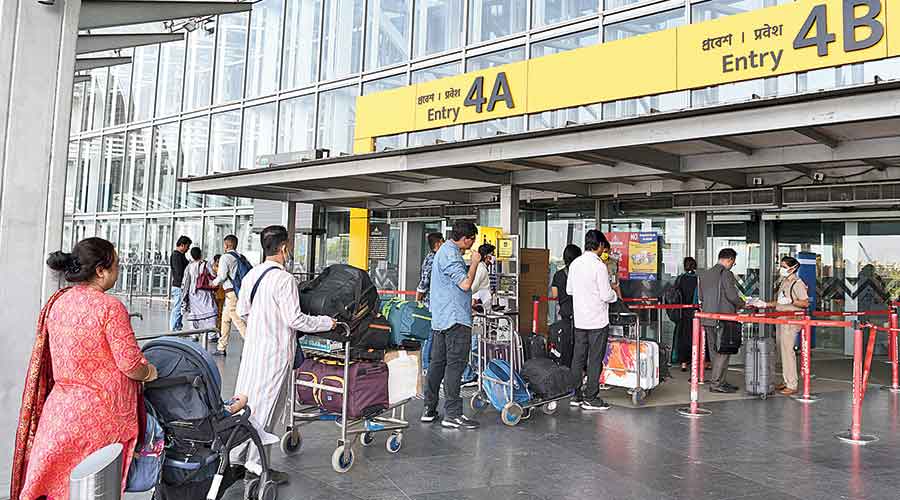It has taken over a decade for the Netaji Subhas Chandra Bose International Airport to introduce a porter service. Even by Calcutta’s own leisurely standards – which the government is projecting to accelerate – this is quite an achievement.
The concept of porter services is not new to Calcutta. They have long been a staple at railway stations throughout Bengal and the country. There is a significant number of unemployed individuals in Bengal, even though the state government claims the unemployment rate is lower than the national average.
Indeed, in most parts of India, from north to the south, manual services are provided by immigrants from West Bengal.
So why has Calcutta Airport lagged in offering this service? If the railways, a government initiative, can provide porters, why can’t the Airports Authority of India? Especially when other government-owned airports already have such services.
There is a clear demand for porters at the airport. The city sees a steady flow of elderly parents visiting their children abroad or across India, as well people travelling with heavy luggage including sportspersons and musicians. Additionally, there is no shortage of unemployed youth who could fill these roles.
Yet, the demand and supply have not aligned.
To find out the answer to this riddle, The Telegraph Online conducted multiple interviews with fliers and stakeholders alike.
Fits and starts
In February this year, the Netaji Subhash Chandra Bose International Airport reintroduced a private concierge service.
The launch has been anything but smooth. After a series of unsuccessful attempts to launch a porter service between 2015 and 2019, it’s almost taken a decade to offer a service that most still find invisible and ineffective.
Back in 2015, The Telegraph had reported that the airport had introduced a no-frills paid porter service in response to passengers being exploited by trolley retrievers posing as assistance staff.
This initiative was more of a deterrent against exploitation than attempts at putting in place a genuine porter service. When compared to the comprehensive porter services available in Mumbai, Bengaluru and Delhi, it was half-hearted and inadequate.
By 2019, the service was discontinued. The contractor, Saptagiri Restaurants Private Limited, struggled to find a willing workforce. Some sources said they also faced political pressure to employ individuals as instructed. It became evident that remaining in the porter business wasn’t practical.
The Telegraph had reported that a strike by contract employees of the service persisted with the backing of the Trinamool Congress.
Approximately 40 contract employees went on strike as Trinamool leaders demanded full payment for absent workers and an eight-hour duty cycle. The service was ultimately discontinued amid ongoing reports of scams involving “trolley retrievers” impersonating airport staff.
Who controls the airport?
After 2019, the absence of porters in an airport despite many passengers asking for it remained unresolved. A part of the problem seemed to stem from a political reluctance to address it. As reported by The Telegraph as far back as in 2013, the airport’s operations have long been influenced by a political tussle involving its union. Not much had changed. Why did it take so long to fix this problem?
The airport is managed by the Airports Authority of India (AAI). In 2023, the civil aviation ministry considered privatising the airport, but the idea was abandoned. Even in the face of political protests, in 2006, GMR, which won the bid to privatise the Delhi airport, wanted to develop the Kolkata airport. That plan met with much resistance and was dropped.
Asked about problems and the absence of an efficient porter service, Trinamool MP Saugata Roy said, “An airport advisory committee looks into any issue with the airport. I am the chairman, and the local administrative representatives are there as well. It is not that we are not aware of issues with the airport. From time to time we raise it and deal with it.”
Speaking to The Telegraph Online on condition of anonymity, a former high-ranking official at the airport spoke his mind: “Due to unionisation, the business viabilities are not met. There are specific requirements for the number of personnel to be employed. But similar to the situation with car parking at the Kolkata airport, contractors there are often instructed to employ people surplus to requirement, which is a perennial problem in Kolkata.”
However, a management consultant once involved in the Delhi airport privatisation believes that while local politics might have played some role, the AAI has systematically eroded the Kolkata airport’s efficiency. “That’s the reason getting basic porter service to taxis seems like climbing a mountain,” he says. “Even the Chennai airport is under the AAI but it is a better managed one.”
He emphasises that Kolkata and Chennai are the only major public sector airports located in states governed by opposition parties, a detail that cannot be overlooked. The civil aviation ministry, meanwhile, has faced criticism on several fronts, particularly during recent reviews of passenger safety. In contrast, the key airports that have undergone privatisation appear notably agile and efficient.
Complicating matters further is the procedural, meeting driven approach favored by local ruling politicians and stakeholders, which sometimes masks underlying interests that undermine airport efficiency. “Committees and meetings can drive progress when there is genuine intent and political will, even if that leadership comes from an opposition party,” the consultant notes.
It seems there’s an inexplicable and crippling affliction unique to Calcutta that overshadows all other concerns when it comes to the airport
Porters and politics of arm-twisting
Multiple conversations with individuals connected to airport unions have highlighted a recurring theme: the Trinamool ultimately controls all major decisions at the airport, from porter services to trolley retrieval.
Asit Sen, general secretary of the NSCBI Airport Ground Worksmen Union, remarked: “The documentation regarding the porter process lacks transparency. Senior leaders of the DumDum Municipality — particularly the chairman and vice-chairman — play a significant role in porter affairs. The local Member of Parliament is often unaware of these specific arrangements.”
The actual number of porters working at the airport remains unclear, with figures on paper not always matching reality. Political parties reportedly call upon contractors to hire workers, sometimes reducing the workdays of existing porters to accommodate these requests, which in turn affects the quality of service.
According to another airport worker, unionisation at the airport now serves political interests rather than the welfare of workers, diminishing the space for quality service for both passengers and staff. The AAI is also compelled to follow directives handed down to them, union leaders say.
In 2017, The Telegraph reported an incident in which a TMC leader allegedly intervened to halt efforts to regulate contractor workers who had come to dominate the integrated terminal.
At the same time, in 2019, MP Saugata Roy is said to have given instructions to remove touts and fix the airport. Yet not much changed and the control of the TMC union in matters of the airport remains. The reason is not difficult to understand, according to some airport workers.
The new offering
From February 2025, for a fee of Rs 700, as informed by the porter desk, porters from the Elite Assist Porter Service are available at the domestic and international departure and arrival terminals. Passengers can also opt for a priority service assistant for an extra Rs 500.
This particular service, part of Travel and Food Services (TFS), which operates food and beverage outlets and lounges at airports, is currently available only at the Kolkata and Goa airports.
The service, former airport director Dr Pravat Ranjan Beuria told The Telegraph Online, “is designed to help passengers with their luggage and provide assistance up to the boarding gate; this service is offered under a commercial contract with the airport authority.”
For domestic departures, gates 1A-B, 2A-B, 3A, and for international departures, gates 4A-B are the designated spots for meeting the porters, both men and women. This service typically requires pre-booking through the service’s website.
“For departure, the porter meets the traveller outside the vehicle, uses a trolley for the luggage, and then accompanies the passenger from the car through the security process, immigration for international travel, and up to the boarding gate,” a person at the porter services desk said, requesting anonymity.
What about arrivals?
“We stand a little away from the aerobridge with a placard and then travel with the passenger until they board a vehicle,” the person explains. The service, he said, is especially of help to the elderly, to business class travelers, and families travelling with children.
“For those who don't have a prior booking, there are two areas at the arrival belts. At belt No. 8 for domestic and belt No. 14 for international, one can book a porter.”
Trapped in time, dogged by inefficiency
How does this play out in reality? Responses received make it seem that the porter services is way behind where it should be - a Telegraph Online My Kolkata report showed how porter trouble continued at the airport even after six months of its launch.
Abhishek Poddar, regional chairman of the Federation of Indian Export Organisations (FIEO), told The Telegraph Online: “The porter service at Kolkata airport remains inefficient and inconsistent, with limited availability and delayed response times during peak hours, which affects the overall passenger experience.”
In agreement with Poddar was Ranodeep Saha, working in the airport retail business. With 63 stores across 48 airports in India, Saha’s work requires him to fly almost every day. In Saha’s mind, Delhi is the best airport, followed by Mumbai and Bengaluru. “Even in smaller airports, the porters are visible. They are looking for business. In Kolkata they are not visible.”
A frequent traveller to the United States said the service in Kolkata was patchy. “This time while departing, I noticed the elite assist booth. We had a lot of luggage and a wheelchair passenger, so I approached the counter, and they promptly provided a wheelchair. It was very convenient,” he said. “But on my return, when the plane landed, their counter inside the international section was unmanned around 8pm."
Debajyoti, a businessman and frequent flier who requested only his first name be used, agreed: “One aspect of the paid porter service at Kolkata airport is that porters are almost invisible. One has to really make an effort to spot a porter if the porter available has not reached out, which is rare but sometimes happens."
In 2016, the Kolkata airport had at least 45 porters working on contract. In 2025, there is little transparency regarding the total number of porters available. Some suggest that the current service has a total staff strength of 35, while some others say there are only 22. The agency that mans the service declined to be interviewed for this article.
“In Delhi and Bangalore, compared to Kolkata, porters actively solicit business,” Debajyoti said. “Such services are also swifter in other Indian airports. It’s rare for this to happen in Kolkata. It could be a mix of factors. People in Kolkata may be unwilling to spend as much as those in other cities for better service, or people may be unwilling to work as porters for a lower salary in Kolkata.”
A senior citizen who is an avid amateur golfer, echoed Debajyoti's opinion: “In Delhi or Bangalore, the porters actively solicit business. Not in Kolkata. Also in the arrival lounge, they cannot be seen. They are there in South India, Varanasi, Agra, etc. Also now in Delhi, though not in Mumbai.”
‘Passengers are often unaware of the service’
The relaunch earlier this year has been relatively smooth, former airport director Beuria said. “So far, there have been no complaints, and the service quality is considered fair, depending on the passenger’s experience. Passengers are encouraged to provide feedback on the service. It is important to note that this is a paid service and not a public service. In the event of a complaint, we will re-engage and provide an alternative service,” he said.
The former airport official who spoke to The Telegraph Online said that when it comes to a better, swifter porter service, visibility of personnel should be minimised and porters should not be roaming around.
“Passengers in Kolkata are often unaware of the services availability. This situation will improve over time, but it is the responsibility of the agency to handle marketing. Private airports have more flexibility to advertise and let people know, whereas we are restricted by certain rules and regulations, which is a fine line to navigate,” he said. “The biggest issue I’ve observed is with touts and taxis. They occupy space without paying any fees.”
Beuria also seemed to hint at a lack of demand for porters. “If there is an increase in demand, the service will be scaled up accordingly,” he says.
He acknowledged that there are several gaps in making things properly efficient, whether the service is paid or not.
Where have all the passengers gone?
Under the AAI, the Kolkata airport has expansion plans till 2030. This includes a plan to demolish its old terminal, with a new terminal set to rise in its place, dedicated to international operations.
The Telegraph had reported in July that the new terminal would handle 11 million passengers annually — 9 million international and 2 million domestic. For the financial year 2024-25, among the top ten busiest airports in India, Kolkata was at No. 6.
Bodhi Banerjee, founder of Greatest Show on Earth Hospitality Private Limited, which caters to foreign tourists during the Durga Puja festival, shared his concerns with The Telegraph Online: “First-time foreigners experience a big shock when they exit the airport. There is no proper queue for taxis, and people are haggling. There is no proper pricing model. Inside the airport, there is a Wi-Fi problem.”
Banerjee’s concerns are similar to Poddar’s who says that airports such as Mumbai, Delhi and Bengaluru offer a more premium, world-class ambience with superior lighting, design layout, and a wider range of luxury retail options.
“In comparison, Kolkata airport currently lacks premium lounges and equivalent service standards. The dining options are also limited, and passengers often experience delays in baggage delivery.” However, Poddar added, “It is encouraging to note the significant improvements in cleanliness and general upkeep at the airport post the pandemic, which have contributed to a better travel environment.”
On the question of the airport not using an opportunity to employ more people as porters, Dr Prithviraj Guha, who teaches economics at Presidency University, looks at it through the lens of demand and supply.
“To stimulate demand, it is essential to inform the public about the porter service, ensuring it is offered at a fair price. Additionally, a well-maintained supply chain can be achieved by employing trained and incentivised workers. Is there enough demand as well as supply for the porter service to be viable, he asks. “If not, then there is a cost to maintaining a captive workforce who may not see sufficient number of customers. This is where it’s different from the Indian Railways.”
As rail travel becomes increasingly expensive, the railway system — along with its unions and the essential porter service, which has largely remained untouched — continues to function with notable efficiency.
The Telegraph report on airport expansion plans also noted the stark difference between domestic and international passengers handled by the airport: roughly 46,000 passengers across 300 domestic flights and about 4500 passengers on 35 international flights. There is no projection for more international passengers.
However, as reported the restructuring will enhance domestic passenger capacity and an additional capacity to handle 2 million passengers.
As these plans progress, whether it involves public transport, taxi, Wi-Fi or private porters, the airport has a golden opportunity to streamline its operations and enhance its services, thereby dispelling the criticism that “nothing happens here”.
“But for that to happen, the political act has to be cleaned first,” said Asit Sen.












